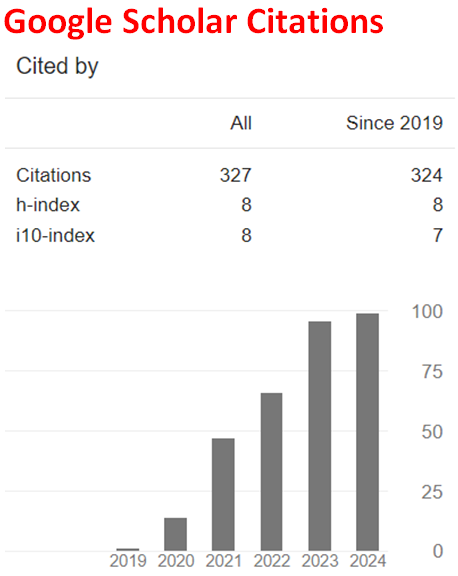Tautomerism in some dihalophenolindophenol dyes – A DFT study
Abstract
Indophenol is a deep blue dye (the group with various substituents). It is found in many dyes used in hair coloring and textile, and found applicability as lubricants, redox materials, liquid crystal displays, etc. A variant of it, dichlorophenol-indophenol, is often used to determine the presence of vitamin C. Indophenol and its derivatives may exhibit resonance-assisted proton tautomerism. In the present study some of those types of tautomers have been investigated within the constraints of density functional theory (DFT) at the level of B3LYP/6-311++G(d,p). All the species presently considered (in vacuum conditions) have not only exothermic heat of formation values but also possess favorable Gibbs free energy of formation values and they are electronically stable. Various structural and quantum chemical data have been collected and discussed including IR and UV-VIS spectra.
Downloads
References
Griffiths, J. (1976). Colour and constitution of organic molecules. London: Academic Press.
Mustroph, H., & Towns, A. (2021). Indophenol and related dyes. Physical Sciences Reviews, 6(8), 315-328. https://doi.org/10.1515/psr-2021-0017
Mustroph, H., & Towns, A. (2022). Indophenol and related dyes. In G. Pfaff (Ed.), Color measurement – metal effect pigments (Vol. 2, pp. 749-764). De Gruyter. https://doi.org/10.1515/9783110587104-038
Searle, P.L. (1984). The Berthelot or indophenol reaction and its use in the analytical chemistry of nitrogen. Analyst, 109, 549-568. https://doi.org/10.1039/an9840900549
Patton, C.J., & Crouch, S.R. (1977). Spectrophotometric and kinetics investigation of the Berthelot reaction for the determination of ammonia. Analytical Chemistry, 49(3), 464-469. https://doi.org/10.1021/ac50011a034
Berneth, H. (2002). Azine dyes. In Ullmann’s encyclopedia of industrial chemistry. Weinheim: Wiley-VCH. https://doi.org/10.1002/14356007.a03_213.pub2
Matsuoka, M. (1990). Infrared absorbing dyes. New York: Plenum Press.
Hughes, D.E. (1983). Titrimetric determination of ascorbic acid with 2,6-dichlorophenol indophenol in commercial liquid diets. Journal of Pharmaceutical Sciences, 72(2), 126-129. https://doi.org/10.1002/jps.2600720208
Cheerlin-Mishma, J.N., Jothy, V.B., Muthu, S., & Irfan, A. (2022). Bonding nature, nucleophilic reactivity and electron excitation of NLO active 2,6-dichloroindophenol sodium salt (polar and non-polar solvents) with topology analysis—bacterial pathogens study. Journal of Molecular Liquids, 367, 120533. https://doi.org/10.1016/j.molliq.2022.120533
Liu, N., & Sun, G. (2011). Photoinduced decolorization of 2,6-dichloroindophenol by 2-anthraquinone sulfonate treated nylon. ACS Appl. Mater. Interfaces, 3(4), 1221-1227. https://doi.org/10.1021/am200047a
Hadler, H.I., Alt, S.K., & Falcone, A.B. (1966). Conjugation of 2,6-dichloroindophenol with mitochondrial thiol groups. Journal of Biological Chemistry, 241(12), 2886-2890. https://doi.org/10.1016/S0021-9258(18)96547-6
Hawkes, W.C., & Craig, K.A. (1990). Automated continuous-flow colorimetric determination of glutathione peroxidase with dichloroindophenol. Analytical Biochemistry, 186(1), 46-52. https://doi.org/10.1016/0003-2697(90)90570-Y
Nakamura, H., Kobayashi, S., Hirata, Y., Suzuki, K., Mogi, Y., & Karube, I. (2007). A spectrophotometric biochemical oxygen demand determination method using 2,6-dichlorophenolindophenol as the redox color indicator and the eukaryote Saccharomyces cerevisiae. Analytical Biochemistry, 369(2), 168-174. https://doi.org/10.1016/j.ab.2007.06.040
Sabnis, R.W. (2007). Handbook of acid-base indicators. CRC Press
Lurie, J. (1975). Handbook of analytical chemistry. Moscow: Mir Publishers.
VanderJagt, D.J., Garry, P.J., & Hunt, W.C. (1986). Ascorbate in plasma as measured by liquid chromatography and by dichlorophenolindophenol colorimetry. Clinical Chemistry, 32(6), 1004-1006. PMID: 3708799
Cabello, C.M., Bair, W.B., Bause, A.S., & Wondrak, G.T. (2009). Antimelanoma activity of the redox dye DCPIP (2,6-dichlorophenolindophenol) is antagonized by NQO1. Biochemical Pharmacology, 78(4), 344-354. https://doi.org/10.1016/j.bcp.2009.04.016
Stewart, J.J.P. (1989). Optimization of parameters for semi-empirical methods I. J. Comput. Chem., 10, 209-220. https://doi.org/10.1002/jcc.540100208
Stewart, J.J.P. (1989). Optimization of parameters for semi-empirical methods II. J. Comput. Chem., 10, 221-264. https://doi.org/10.1002/jcc.540100209
Leach, A.R. (1997). Molecular modeling. Essex: Longman.
Kohn, W., & Sham, L.J. (1965). Self-consistent equations including exchange and correlation effects. Phys. Rev., 140, 1133-1138. https://doi.org/10.1103/PhysRev.140.A1133
Parr, R.G., & Yang, W. (1989). Density functional theory of atoms and molecules. London: Oxford University Press.
Becke, A.D. (1988). Density-functional exchange-energy approximation with correct asymptotic behavior. Phys. Rev. A, 38, 3098-3100. https://doi.org/10.1103/PhysRevA.38.3098
Vosko, S.H., Wilk, L., & Nusair, M. (1980). Accurate spin-dependent electron liquid correlation energies for local spin density calculations: a critical analysis. Can. J. Phys., 58, 1200-1211. https://doi.org/10.1139/p80-159
Lee, C., Yang, W., & Parr, R.G. (1988). Development of the Colle-Salvetti correlation energy formula into a functional of the electron density. Phys. Rev. B, 37, 785-789. https://doi.org/10.1103/PhysRevB.37.785
SPARTAN 06 (2006). Wavefunction Inc. Irvine CA, USA.
Zubatyuk, R.I., Volovenko, Y.M., Shishkin, O.V., Gorb, L., & Leszczynski, J. (2007). Aromaticity-controlled tautomerism and resonance-assisted hydrogen bonding in heterocyclic enaminone–iminoenol systems. The Journal of Organic Chemistry, 72(3), 725-735. https://doi.org/10.1021/jo0616411
Fleming, I. (1976). Frontier orbitals and organic reactions. London: Wiley.
Turro, N.J. (1991). Modern molecular photochemistry. University Science Books.

This work is licensed under a Creative Commons Attribution 4.0 International License.


